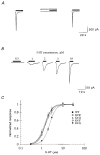The 4'lysine in the putative channel lining domain affects desensitization but not the single-channel conductance of recombinant homomeric 5-HT3A receptors
- PMID: 10639097
- PMCID: PMC2269757
- DOI: 10.1111/j.1469-7793.2000.00187.x
The 4'lysine in the putative channel lining domain affects desensitization but not the single-channel conductance of recombinant homomeric 5-HT3A receptors
Abstract
The 5-HT3 receptor is a transmitter-gated ion channel of the Cys-loop superfamily. Uniquely, 5-HT3 receptor subunits (5-HT3A and 5-HT3B) possess a positively charged lysine residue within the putative channel lining M2 domain (4' position). Using whole cell recording techniques, we examined the role of this residue in receptor function using wild-type (WT) and mutant 5-HT3A receptor subunits of murine origin transiently expressed in human embryonic kidney (HEK 293) cells. WT 5-HT3A receptors mediated rapidly activating currents in response to 5-HT (10-90 % rise time, 103 ms; EC50, 2.34 microM; Hill coefficient, nH, 2.87). The currents rectified inwardly, reversed in sign at a potential of -9 mV and desensitized in the continuous presence of agonist (half-time of desensitization, t(1/2), 2.13 s). 5-HT3A receptor subunits in which the 4'lysine was mutated to arginine, glutamine, serine or glycine formed functional receptors. 5-HT EC50 values were approximately 2-fold lower than for WT 5-HT3A receptors, but Hill coefficients, kinetics of current activation, rectification, and reversal potentials were unaltered. Each of the mutants desensitized more slowly than the WT 5-HT3A receptor, with the arginine and glycine mutations exhibiting the greatest effect (5-fold reduction). The rank order of effect was arginine > glycine > serine > glutamine. The single-channel conductance of the WT 5-HT3A receptor, as assessed by fluctuation analysis of macroscopic currents, was 390 fS. A similar value was obtained for the 4'lysine mutant receptors. Thus it appears unlikely that 4'lysine is exposed to the channel lumen. Mutation of residues immediately adjacent to 4'lysine to glutamate or lysine resulted in lack of receptor expression or function. We conclude that 4'lysine does not form part of the channel lining, but may play an important role in 5-HT3 receptor desensitization.
Figures






Similar articles
-
Open probability of homomeric murine 5-HT3A serotonin receptors depends on subunit occupancy.J Physiol. 2001 Sep 1;535(Pt 2):427-43. doi: 10.1111/j.1469-7793.2001.00427.x. J Physiol. 2001. PMID: 11533135 Free PMC article.
-
A cytoplasmic region determines single-channel conductance in 5-HT3 receptors.Nature. 2003 Jul 17;424(6946):321-4. doi: 10.1038/nature01788. Nature. 2003. PMID: 12867984
-
Ion permeation and conduction in a human recombinant 5-HT3 receptor subunit (h5-HT3A).J Physiol. 1998 Mar 15;507 ( Pt 3)(Pt 3):653-65. doi: 10.1111/j.1469-7793.1998.653bs.x. J Physiol. 1998. PMID: 9508827 Free PMC article.
-
The 5-hydroxytryptamine type 3 (5-HT3) receptor reveals a novel determinant of single-channel conductance.Biochem Soc Trans. 2004 Jun;32(Pt3):547-52. doi: 10.1042/BST0320547. Biochem Soc Trans. 2004. PMID: 15157181 Review.
-
The molecular basis of the structure and function of the 5-HT3 receptor: a model ligand-gated ion channel (review).Mol Membr Biol. 2002 Jan-Mar;19(1):11-26. doi: 10.1080/09687680110110048. Mol Membr Biol. 2002. PMID: 11989819 Review.
Cited by
-
Modulation of 5-HT3 receptor desensitization by the light chain of microtubule-associated protein 1B expressed in HEK 293 cells.J Physiol. 2008 Feb 1;586(3):751-62. doi: 10.1113/jphysiol.2007.136440. Epub 2007 Dec 6. J Physiol. 2008. PMID: 18063656 Free PMC article.
-
Unparalleled control of neural activity using orthogonal pharmacogenetics.ACS Chem Neurosci. 2012 Aug 15;3(8):619-29. doi: 10.1021/cn300053q. Epub 2012 Jun 1. ACS Chem Neurosci. 2012. PMID: 22896806 Free PMC article. Review.
-
A single ring of charged amino acids at one end of the pore can control ion selectivity in the 5-HT3 receptor.Br J Pharmacol. 2003 Sep;140(2):359-65. doi: 10.1038/sj.bjp.0705424. Epub 2003 Aug 11. Br J Pharmacol. 2003. PMID: 12970096 Free PMC article.
-
Co-expression of the 5-HT3B serotonin receptor subunit alters the biophysics of the 5-HT3 receptor.Biophys J. 2003 Mar;84(3):1720-33. doi: 10.1016/S0006-3495(03)74980-7. Biophys J. 2003. PMID: 12609874 Free PMC article.
-
The 5-HT3 receptor--the relationship between structure and function.Neuropharmacology. 2009 Jan;56(1):273-84. doi: 10.1016/j.neuropharm.2008.08.003. Epub 2008 Aug 12. Neuropharmacology. 2009. PMID: 18761359 Free PMC article. Review.
References
-
- Akabas MH, Kaufmann C, Archdeacon P, Karlin A. Identification of acetylcholine receptor channel-lining residues in the entire M2 segment of the α-subunit. Neuron. 1994;13:919–927. - PubMed
-
- Barnard EA. The transmitter-gated channels: a range of receptor types and structures. Trends in Pharmacological Sciences. 1996;17:305–309. - PubMed
-
- Barry PH, Lynch JW. Liquid junction potentials and small cell effects in patch-clamp analysis. Journal of Membrane Biology. 1991;121:101–117. - PubMed
-
- Belelli D, Balcarek JM, Hope AG, Peters JA, Lambert JJ, Blackburn TP. Cloning and functional expression of a human 5-hydroxytryptamine type 3AS receptor subunit. Molecular Pharmacology. 1995;48:1054–1062. - PubMed
Publication types
MeSH terms
Substances
LinkOut - more resources
Full Text Sources
Miscellaneous

